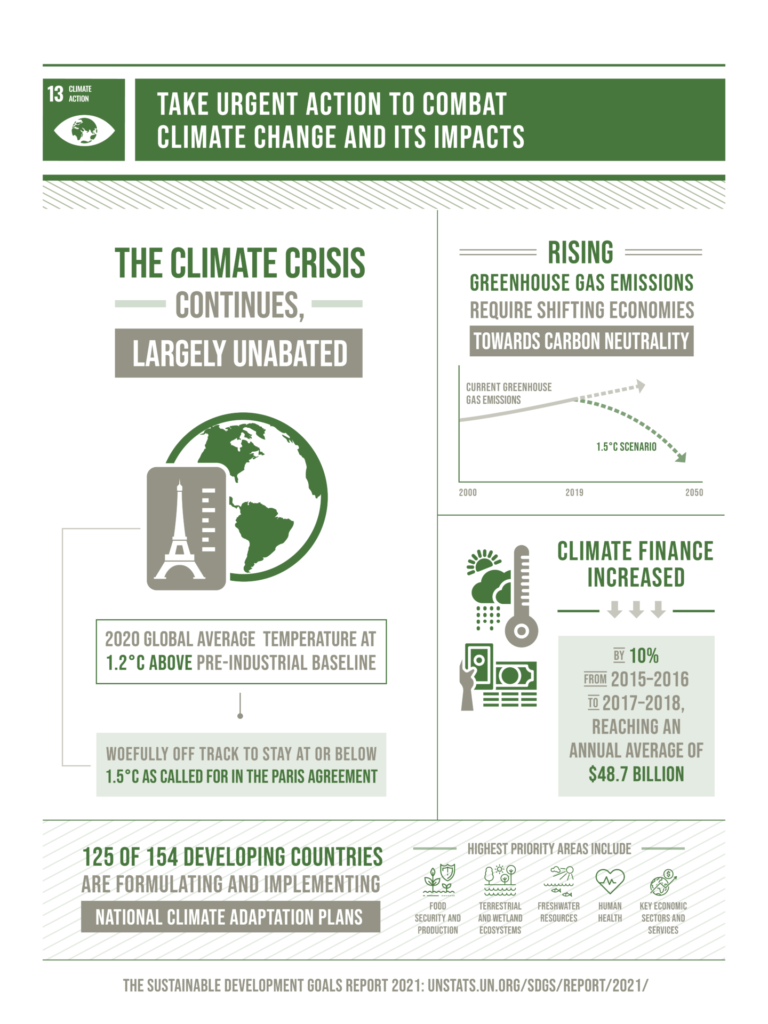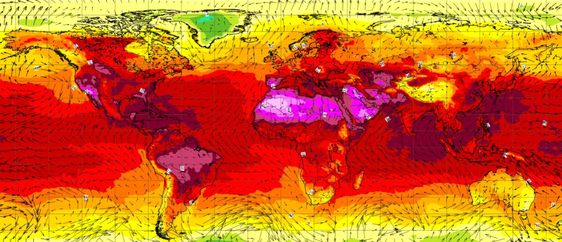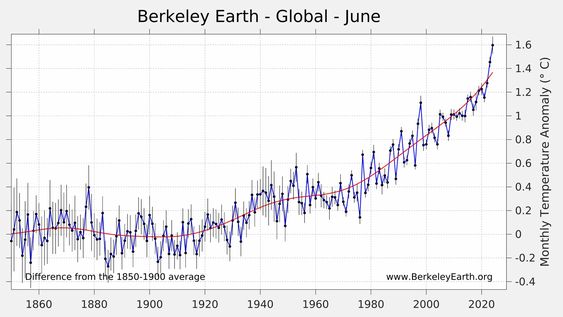
Current climate policies will reduce emissions, but not quickly enough to reach international targets
Current policies to reduce, or at least slow down growth, in CO2 and other greenhouse gas emissions, will have some impact on reducing future warming.
As we see in the chart shown here, current implemented climate and energy policies would reduce warming relative to a world with no climate policies in place. This chart maps out future greenhouse gas emissions scenarios under a range of assumptions: if no climate policies were implemented; if current policies continued; if all countries achieved their current future pledges for emissions reductions; and necessary pathways which are compatible with limiting warming to 1.5°C or 2°C of warming this century.14
If countries achieved their current ‘Pledges’ (also shown on the chart), this would be an even further improvement. In this regard, the world is making some progress.
But if our aim is to limit warming to “well below 2°C” – as is laid out in the Paris Agreement – we are clearly far off-track.
Robbie Andrew, senior researcher at the Center for International Climate Research (CICERO), mapped out the global emissions reduction scenarios necessary to limit global average warming to 1.5°C and 2°C. Based on the IPCC’s Special Report on 1.5°C and Michael Raupach’s work, published in Nature Climate Change, these mitigation curves show that urgent and rapid reductions in emissions would be needed to achieve either target.15,16,17 And the longer we delay a peak in emissions, the more drastic these reductions would need to be.
We may be making slow progress relative to a world without any climate policies, but we are still far from the rates of the progress we’d need to achieve international targets.
Can we make progress in reducing emissions?
Some countries reduced emissions whilst increasing GDP – even when we take into account outsourced production
There is a strong link between CO2 emissions, prosperity, and standards of living – we look at this in much more detail, with the data, in our page on Emissions Drivers.
Therefore, if we’re to ask the question: “have any countries demonstrated that we can make progress in reducing emissions?”, they would have to achieve both:
- High standards of living;
- Low levels of emissions, or at least large reductions in emissions to maintain that standard of living.
There are many countries that meet one criterion: rich countries that have high standards of living, but also high levels of emissions; and poor countries that have low levels of emissions but poor standards of living.
But, some countries have shown signs of progress. A number of countries have shown in recent years that it is possible to increase GDP whilst also reducing emissions. We see this in the chart which shows the change in GDP, GDP per capita, and annual CO2 emissions. Both production- and consumption-based CO2 emissions are shown – consumption-based emissions correct for traded goods and services, so we can see whether emissions reductions were only achieved by “offshoring” production to other countries.
A number of countries – such as the USA, UK, France, Spain, Italy, and many others – have managed to reduce emissions (even when we correct for trade) whilst increasing GDP.
The more important question is “Can we make progress fast enough?”
So we can see numerous examples of countries, with high standards of living, which have been successful in reducing emissions. This is a clear signal that it is possible to make progress.
But the key question here is probably less: “can we make progress?”, but rather “can we make progress fast enough?”.
As we explored earlier in this article, the world is currently far off-track from our 2°C target. If this is our definition of “fast enough” then we have little historical evidence to suggest that most, or even some, countries can reduce emissions (whilst maintaining high living standards) at the speed needed to achieve this.
We can make progress, but it’s currently too slow. We need large-scale acceleration of these efforts across the world.
How do we make progress in reducing emissions?
To make progress in reducing greenhouse gas emissions, there are two fundamental areas we need to focus on: energy (this encapsulates electricity, heat, transport, and industrial activities) and food and agriculture (which includes agriculture and land-use change, since agriculture dominates global land use).
Below we’ve listed some of the key actions we need to make progress in each area. At a very basic level they can be summarised by two core concepts: improving efficiency (using less energy to produce a given output; and using less land, fertilizer, and other inputs for food production, and reducing food waste); and transitioning to low-carbon alternatives (in energy, this means shifting to renewables and nuclear; for food, this means substituting carbon-intensive products for those with a lower carbon footprint).
How can we decarbonize our energy systems?
- Shift towards low-carbon electricity (reduce carbon intensity – carbon per unit energy)
– Renewables
– Nuclear energy
– Shift from coal to gas (which emits less CO2 per unit energy) as an interim step
→ Explore our work on energy.
→ Explore our data on CO2 emissions by fuel type - Shift sectors such as transport, towards electricity. Some energy sectors are harder to decarbonize – for example, transport. We therefore need to shift these forms towards electricity where we have viable low-carbon technologies.
→ Explore our data on greenhouse gas emissions by sector. - Develop low-cost low-carbon energy and battery technologies. To do this quickly, and allow lower-income countries to avoid high-carbon development pathways, low-carbon energy needs to be cost-effective and the default choice.
- Improve energy efficiency – energy per unit GDP.
→ Explore our data on energy intensity.
How can we reduce emissions from food production and agriculture?
- Reduce meat and dairy consumption, especially in higher-income countries. Shift dietary patterns towards lower-carbon food products. This includes eating less meat and dairy generally, but also substituting high-impact meats (e.g. beef and lamb) for chicken, fish, or eggs. Innovation in meat substitutes could also play a large role here.
→ Read our article on the carbon footprint of meat and dairy versus alternative foods.
→ Explore our work on meat and dairy production. - Promote lower-carbon meat and dairy production. We are not going to cut out meat and dairy production completely any time soon (and doing so is unnecessary – large reductions would be sufficient). This makes the promotion of lower-carbon production methods essential.
→ Read our article on the large differences in carbon footprint for specific meat and dairy products. - Improve crop yields. Sustainable intensification of agriculture allows us to grow more food on less land. This could help to prevent deforestation from agricultural expansion, and frees up land for replanting, or giving back to natural ecosystems.f
→ Explore our work on Crop Yields. - Reduce food waste. Around one-third of food emissions come from food that is lost in supply chains or wasted by consumers. Improving harvesting techniques, refrigeration, transport and packaging in supply chains; and reducing consumer waste can reduce emissions significantly.
→ Read our article on GHG emissions from Food Waste.
Kaya Identity: what drives CO2 emissions?

What drives, and ultimately determines levels of CO2 emissions – whether at global; regional; national or local levels? Total CO2 emissions are driven by four fundamental factors, outlined in the well-known equation: the ‘Kaya Identity‘. The breakdown of the Kaya Identity equation is shown in the graphic here. In the sections below we look at the role of these different factors in driving emissions.
Total emissions, in the simplest description, are determined by:
- Population: number of people
- Per capita impact: average emissions per person
Per capita emissions are determined by:
- Income: GDP per capita – richer people tend to emit more CO2
- Technology: how much CO2 is emitted per dollar spent
‘Technology’ is determined by two factors:
- Energy intensity: the amount of energy consumed per unit of GDP
- Carbon intensity: the amount of CO2 emitter per unit of energy
This means that total emissions are driven by the equation:


United Nations Global Goals for Sustainable Development
2019 was the second warmest year on record and the end of the warmest decade (2010- 2019) ever recorded and carbon dioxide (CO2) levels and other greenhouse gases in the atmosphere rose to new records in 2019.
Climate change is affecting every country on every continent. It is disrupting national economies and affecting lives. Weather patterns are changing, sea levels are rising, and weather events are becoming more extreme.
Although greenhouse gas emissions are projected to drop about 6 percent in 2020 due to travel bans and economic slowdowns resulting from the COVID-19 pandemic, this improvement is only temporary. Climate change is not on pause. Once the global economy begins to recover from the pandemic, emissions are expected to return to higher levels.
Saving lives and livelihoods requires urgent action to address both the pandemic and the climate emergency.
The Paris Agreement, adopted in 2015, aims to strengthen the global response to the threat of climate change by keeping a global temperature rise this century well below 2 degrees Celsius above pre-industrial levels. The agreement also aims to strengthen the ability of countries to deal with the impacts of climate change, through appropriate financial flows, a new technology framework, and an enhanced capacity-building framework.
COVID-19 response
As countries move toward rebuilding their economies after COVID-19, recovery plans can shape the 21st-century economy in ways that are clean, green, healthy, safe, and more resilient. The current crisis is an opportunity for a profound, systemic shift to a more sustainable economy that works for both people and the planet.
The UN Secretary-General has proposed six climate-positive actions for governments to take once they go about building back their economies and societies:
- Green transition: Investments must accelerate the decarbonization of all aspects of our economy.
- Green jobs and sustainable and inclusive growth
- Green economy: making societies and people more resilient through a transition that is fair to all and leaves no one behind.
- Invest in sustainable solutions: fossil fuel subsidies must end and polluters must pay for their pollution.
- Confront all climate risks
- Cooperation – no country can succeed alone.
To address the climate emergency, post-pandemic recovery plans need to trigger long-term systemic shifts that will change the trajectory of CO2 levels in the atmosphere.
Governments around the world have spent considerable time and effort in recent years to develop plans to chart a safer and more sustainable future for their citizens. Taking these on board now as part of recovery planning can help the world build back better from the current crisis.
Facts and Figures
- As of April 2018, 175 parties had ratified the Paris Agreement and 168 parties had communicated their first nationally determined contributions to the UN framework convention on Climate Change Secretariat.
- As of April 2018, 10 developing countries had successfully completed and submitted their first iteration of their national adaptation plans for responding to climate change.
- Developed country parties continue to make progress towards the goal of jointly mobilizing $100 billion annually by 2020 for mitigation actions.
Thanks to the Intergovernmental Panel on Climate Change we know:
- From 1880 to 2012, average global temperature increased by 0.85°C. To put this into perspective, for each 1 degree of temperature increase, grain yields decline by about 5 percent. Maize, wheat and other major crops have experienced significant yield reductions at the global level of 40 megatons per year between 1981 and 2002 due to a warmer climate.
- Oceans have warmed, the amounts of snow and ice have diminished and sea level has risen.From 1901 to 2010, the global average sea level rose by 19 cm as oceans expanded due to warming and ice melted. The Arctic’s sea ice extent has shrunk in every successive decade since 1979, with 1.07 million km² of ice loss every decade
- Given current concentrations and on-going emissions of greenhouse gases, it is likely that by the end of this century, the increase in global temperature will exceed 1.5°C compared to 1850 to 1900 for all but one scenario. The world’s oceans will warm and ice melt will continue. Average sea level rise is predicted as 24 – 30cm by 2065 and 40-63cm by 2100. Most aspects of climate change will persist for many centuries even if emissions are stopped
- Global emissions of carbon dioxide (CO2) have increased by almost 50 percent since 1990
- Emissions grew more quickly between 2000 and 2010 than in each of the three previous decades
- It is still possible, using a wide array of technological measures and changes in behavior, to limit the increase in global mean temperature to two degrees Celsius above pre-industrial levels
- Major institutional and technological change will give a better than even chance that global warming will not exceed this threshold
Goal 13 Targets
13.1 Strengthen resilience and adaptive capacity to climate-related hazards and natural disasters in all countries
13.2 Integrate climate change measures into national policies, strategies, and planning
13.3 Improve education, awareness-raising, and human and institutional capacity on climate change mitigation, adaptation, impact reduction, and early warning
13.A Implement the commitment undertaken by developed-country parties to the United Nations Framework Convention on Climate Change to a goal of mobilizing jointly $100 billion annually by 2020 from all sources to address the needs of developing countries in the context of meaningful mitigation actions and transparency on implementation and fully operationalize the Green Climate Fund through its capitalization as soon as possible
13.B Promote mechanisms for raising capacity for effective climate change-related planning and management in the least developed countries and small island developing States, including focusing on women, youth, and local and marginalized communities
*Acknowledging that the United Nations Framework Convention on Climate Change is the primary international, intergovernmental forum for negotiating the global response to climate change.
Links
UN Framework on the Convention on Climate Change
World Meteorological Organization
UN Environment – Climate Change
Intergovernmental panel on Climate Change






4 Comments
Pingback: relaxing music sleep
Pingback: buying lsd in canada
Pingback: sex children
Pingback: ฟิล์มกรองแสง